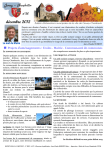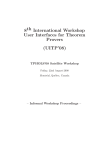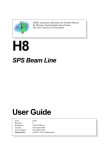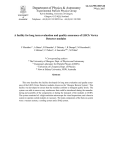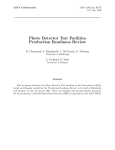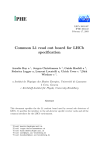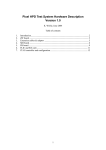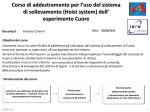Download Quality Assurance - TWiki
Transcript
LHCb Project Document EDMS No 948 074 V 1.0 Date: dd-mmm-2008 Page 1 of 23 Operational Procedure OPERATIONAL PROCEDURES FOR THE RICH DETECTORS This document defines the procedures for the safe operation and maintenance of the RICH-1 and RICH-2 sub-detectors of the LHCb detector. IMPORTANT: The procedures described therein are in line with the safety rules and regulations at CERN and have to be strictly followed. Keywords: Safety, RICH, procedure Prepared by: Checked by: Approved by: Carmelo D’Ambrosio Christoph Frei Thomas Blake Date: dd-month-2008 Neville Harnew Olivier Callot, Eric Thomas, Werner Witzeling Date: dd-month-2008 Date: dd-month-2008 Distribution: Subdetector Group, Operations LHCb Project Document EDMS No 948 074 V 1.0 Date: dd-mmm-2008 Page 2 of 23 1.1.1.1 History of Changes Version Date 1.0 dd-mmm2008 Pages Comments or description of changes First version, draft 1 LHCb Project Document EDMS No 948 074 V 1.0 Date: dd-mmm-2008 Page 3 of 23 Contents 1 OVERVIEW ......................................................................................................... 5 2 DESCRIPTION OF SPECIFIC SAFETY SYSTEMS AND INTERLOCKS .......... 6 2.1 Detector Safety System (DSS) ..................................................................................... 6 2.2 Experiment Control System (ECS) ............................................................................. 7 3 PROCEDURES FOR STANDARD OPERATION ............................................... 7 3.1 Instructions to be applied for safe starting up and shutting down of system ......... 7 3.2 Low voltage supply ....................................................................................................... 7 3.3 Silicon Bias .................................................................................................................... 8 3.4 High Voltage ................................................................................................................. 8 3.5 From the Control Room, procedures to be applied for safe operation of the RICH detectors: ................................................................................................................................... 9 3.6 Run Control and Operation ...................................................................................... 11 3.7 Online Monitoring ...................................................................................................... 11 3.8 Typical DAQ errors and their solutions................................................................... 12 3.9 Standard Parameters for safe operation .................................................................. 13 3.10 Atmosphere in HPD enclosures ................................................................................ 14 3.11 Cooling of the HPD electronics ................................................................................. 15 3.12 Mirror alignment........................................................................................................ 16 4 PROCEDURES FOR ROUTINE MAINTENANCE ............................................ 16 4.1 Atmosphere in HPD enclosures ................................................................................ 16 4.2 Cooling of the HPD electronics ................................................................................. 17 4.3 Radiation Protection .................................................................................................. 17 4.4 Beam Pipe Protection ................................................................................................. 17 LHCb Project Document EDMS No 948 074 V 1.0 Date: dd-mmm-2008 Page 4 of 23 5 PROCEDURES FOR SPECIAL INTERVENTIONS .......................................... 17 5.1 Replacing an ISEG HV supply .................................................................................. 17 5.2 RICH 2 - Access to HPD enclosures ......................................................................... 18 5.3 RICH 2 - Intervention on HPDs or its electronics................................................... 19 5.4 RICH2 - Access to the gas enclosure ........................................................................ 19 5.5 RICH2 - Closing of the gas enclosure ....................................................................... 20 5.6 RICH 1 ........................................................................................................................ 20 5.7 Replacing a fuse, Level-0 or Low Voltage Board .................................................... 20 5.8 Replacing a HPD ........................................................................................................ 21 6 APPENDIX A: STANDARD OPERATING PARAMETERS ............................. 22 LHCb Project Document EDMS No 948 074 V 1.0 Date: dd-mmm-2008 Page 5 of 23 1 Overview The particle identification system of LHCb is comprised of two Ring Imagining Cherenkov Detectors (RICH) detectors, flanked by a tracking system, calorimeters and muon detectors. The RICH 1 detector covers the full angular acceptance of the spectrometer, from 10 to 300 mrad in the horizontal projection (the bending plane), and 10 to 250 mrad in the vertical projection. Two active media, very close to the interaction point, ensure a wide angle and low to medium momentum coverage. To ensure the physics goals of LHCb can be met RICH 2 provides positive kaon identification of higher momentum, up to 100 GeV/c, particles. These tend to lie at small opening angles to the beam pipe and the coverage of RICH 2 is therefore limited to 120 mrad times 100 mrad. The two RICH detectors are built around the same model. Charged particles traversing a radiator volume generate Cherenkov light which is then focused by a system of spherical and flat mirrors onto planes of photon detectors. The position of hits on these planes is then used to estimate the likelihood that the particle is, for example, a kaon rather than a pion. The planes are made up from a total of 484 pixel Hybrid Photon Detectors (HPDs) split across the two detectors. Each HPD contains a silicon pixel detector comprising 8192 elements which can be read out in two modes, either as single elements (ALICE mode) or as groups of eight actively OR-ed elements (LHCb mode). The latter gives a resolution on the photocathode of about 2.5 x 2.5 mm2 and is the standard (PHYSICS) operating mode of the RICH detectors. Data readout is performed at a sustained average of ~1 MHz rate, reduced from 40 MHz by LHCb level zero trigger. As such, the RICHes are two closed boxes surrounding the beam pipe before and after the magnet with TT and OT detectors in between. The two boxes are monitored continuously for temperature, pressure, humidity and light integrity. The front end of the RICH detectors is arranged as independent columns. Each column contains either 14 (for RICH 1) or 16 (RICH 2) HPDs and their associated electronics. Pairs of HPDs share L0 readout boards, LV and HV supply boards. LHCb Project Document EDMS No 948 074 V 1.0 Date: dd-mmm-2008 Page 6 of 23 2 Description of Specific Safety Systems and Interlocks The safety protection system of the RICH detectors can be split into two parts. Actions triggered directly by the RICH detector safety system (DSS) and those triggered by the RICH Experiment Control System (ECS). 2.1 Detector Safety System (DSS) The DSS concerns equipment protection and is described in detail in document EDMS:830673. An overview of the DSS alarm matrix is provided in Figure 1. The DSS provides protection for the racks, continuous monitoring of the cooling flow to the RICH electronics, environmental monitoring of the HPD enclosures (through Pt100 sensor and thermo switches). It also acts on the light-tightness of the enclosures through physical switches and a light-leak detector 1 . If an alarm is raised the DSS system will directly cut power to the racks. Figure 1: Detector Safety System (DSS) alarm matrix. 1 For detailed instructions on the use of the light leak detection system see https://lbtwiki.cern.ch/bin/view/RICH/RichPower/blac.pdf LHCb Project Document EDMS No 948 074 V 1.0 Date: dd-mmm-2008 Page 7 of 23 2.2 Experiment Control System (ECS) The actions of the ECS system are complementary to, and deliberately overlap those of, the DSS. In the advent of a DSS alarm the ECS system of the RICH will ramp down all of the supply voltages in a controlled manner before the racks are interlocked. In addition the ECS monitors: • the temperature of the LV regulators, • the current drawn by the CAEN silicon bias and Wiener Maraton supplies, • the cooling pressure. The High Voltage daemon running on a credit card PC (CCPC) will act on the high voltage supply if the high voltage goes under or over current (or voltage). The daemon will only trigger the switching off of the column(s) concerned and HV can remain supplied to over columns. 3 3.1 Procedures for Standard Operation Instructions to be applied for safe starting up and shutting down of system The front end of the RICH detectors is supplied with two low voltages (of 4.4V and 5.4V), a biasing voltage (for the HPDs pixel sensor) of 80V and a high voltage of up to 20kV. This single HV line supplies the three biasing voltages of the HPD electrodes via a divider at the front end. 3.2 Low voltage supply The Low Voltage power supply system is based around the Wiener Maraton (EDMS:792758). Two of the component pieces are located in the RICH racks in D3 (PFCs and controller modules) whilst the front-end marathon boxes are located close to the RICH detectors, on the balcony for RICH 1 (P1A05) and in the bunker for RICH 2 (racks T0A05 and T0A15). To power on the voltage system the power-on sequence is as follows: • Switch on controller modules, located in 6U VME crates in D3C02 and D3C05. The VME crates have ON/OFF switches. One on the power supply at the rear of LHCb Project Document EDMS No 948 074 V 1.0 Date: dd-mmm-2008 Page 8 of 23 the crate and the second on the main front-panel of the crate. When turned-on the modules will start up automatically. • The PFCs (Power Factor Correction), rectifiers, should be switched on. These are found in 4U racks (D3C02 and D3C05). • Switch on the Maraton boxes in racks P1A05 (RICH 1), T0A05 (RICH 2) and T0A15 (RICH 2). The control of the L0 boards at the front-end is performed via a SPECS slave on the columns. Communication with the SPECS slave is performed by 32 DIM servers (running on r1daq01w, r1daq02w, r2daq01w and r2daq02w machines). These need to be running before the front-end can be configured and the LV regulators switched on. 3.3 Silicon Bias The reverse bias voltage for the HPDs silicon pixel sensor is provided by the CAEN SYS1527. The modules and patch panels are located in the following racks in D3: D3C02 (RICH 1) and D3C05 (RICH2). The following steps are required to power-on the CAENs: • The crates have two ON/OFF switches. One on the rear of the crate and a turn-key switch on the front of the crate. The switch at the rear should be turned on and the key turned to “local control”. • The channels on the patch panel should be enabled. The power off sequences for the LV and the silicon bias are the reverse of the sequences given above. 3.4 High Voltage The HV for the front-end of the RICH detectors is provided by ISEG (CPn 200 504 24 10) supplies, controlled and monitored by a pair of DACs and ADCs via an I2C bus connected to a CCPC (credit card PC). The HV modules and their 24V DC supplies are located in D3 (rack D3C06 for RICH 2 and D3C03 for RICH 1). Each ISEG contains a splitter to supply the two half-columns of the front-end from a single HV supply. The control of the HV is carried out through the CCPC and described in detail below. The HV control is always on when power is supplied to the racks in D3. To enable the HV the user should: LHCb Project Document EDMS No 948 074 V 1.0 Date: dd-mmm-2008 Page 9 of 23 • check the status of the light leak detector, • turn on the crate containing the CCPC and the 24V supply (D3C06 and D3C03), • build the ram disk and start the daemon on the CCPC (details on how to do this can be found later in this document), • operate the HV through the PVSS panel. The HV has three levels of readiness: • GO_STANDBY1, ramping the HV to 3kV, • GO_STANDBY2, ramping to 13kV, • GO_READY, that ramps directly to 18kV. Under standard operating conditions GO_READY action should be used. 18 kV is currently the standard operating voltage of the RICH detectors. The rate at which the HV is ramped is controlled by PVSS; it should not exceed: 50 Vs-1 between 0 and 10 kV, 20 Vs-1 from 10 to 15 kV and 10 Vs-1 above 15 kV. Ideally the HV should be ramped to 18kV and then left to stabilize for at least one hour prior to data taking. If this is not possible the RICH detectors will see an increased noise rate (due to charge settling effects). If the HV is not responsive (or after a power cut) the user should check the status of the HV daemon running on the CCPC. This daemon runs on the Linux machines r1hv01 and r2hv02 for RICH 1 and 2 respectively. HVSetup will tell you if the daemon is running. If the daemon is not running it can be started manually using the script /group/rich/HV/hvcont_start_daemon.sh. If recovering after a power intervention then it may also be necessary to re-build the disk image of the CCPC. This can be done using the script /group/rich/HV/hvcont_create_ramdisk.sh 3.5 Procedures to be applied for safe operation of the RICH detectors: The following procedures should be followed during operation of the RICH detector: • Check for DSS alerts and/or warnings. • Check that cooling is ON and that the cooling flow / pressure is adequate (this is described later in this document). LHCb Project Document EDMS No 948 074 V 1.0 Date: dd-mmm-2008 Page 10 of 23 • Check that Light Leak Detector is ON. The light leak detector triggers an interlock of the HV system if the light level inside the RICH vessels exceeds 7.0 (arb. units). This level is continuously monitored by a set of photomultipliers within the HPD volume of RICH 1 and RICH 2. If the light exceeds 7.0 the HV will be interlocked and the interlock will have to be manually removed from the Light Leak Detector in D3C06 or 03 for RICH 2 and 1 respectively. This will also trigger a DSS alarm. If any of these are in an ‘ERROR’ state they must be rectified before the RICH can operate. They will also trigger a power down of the RICH detectors. In addition the operator must check the status of the RICH on these panels: • RICH Overview, • HPD Environment. • CF4 and C4F10 environment. There are separate panels for RICH 1 and 2 and are accessible from the G:\rich\shift directory. It is particularly important to check the status of the LV and HV on the RICH Overview panel. The HV on this panel is monitored through a protection board and ELMB from the front end HV boards. Finally the FSMs have to be in taken status (no SHARE nor RELEASE ALL) and resources allocated. If the RICH is in a safe (READY) state, the RICH DCS can then be operated to POWER_ON on the RICH electrons, providing both the LV and the silicon bias voltages to the L0 boards and HPDs at the front end. During normal running the HV should be on before the electronics is powered. It is currently standard practice to not include the HV FSM in the full RICH (RICH 1 or RICH 2) FSM tree. These should instead be taken at a lower level and locked out at the level of the ECS projects. This ensures that HV control is not part of the general RICH operation, i.e. HV should remain on and only be turned off for interventions on the hardware. The RICH can now be configured from the top most FSM and a run started. LHCb Project Document EDMS No 948 074 V 1.0 Date: dd-mmm-2008 Page 11 of 23 3.6 Run Control and Operation There are a number of different recipes available for data taking: • PHYSICS (and PHYSICS|…). When operating the RICH a L0 bunch gap of 1 should ALWAYS be asserted. • ALICE. For operation of the HPDs with the smaller (62.5 um) pixel size. Note that random triggers should not be used (i.e. use Calibration A or C triggers) and due to the larger event size a bunch gap of 32 crossings should be used. • ALICE|MDMS. A special recipe designed for taking Calibration runs with the RICH 1 magnetic distortion monitoring system. This will remove the MDMS light bar from its parked position and step across the photon detector plane in 3515 steps. The light bar will be automatically parked when the run finishes. In all other respects this recipe functions like the ALICE recipe. PHYSICS is the standard recipe for data taking. Other recipes may be used during detector commissioning but should not be used during normal operation. 3.7 Online Monitoring RICH monitoring histograms can be viewed by following the standard procedure of: • opening the presenter by running startOfficalMonitor from any plus node, • selecting the RICH or the RICH 1 / 2 partition (during commissioning), • navigating to the RICH database page. Histograms on this page are continuously updated by the RICH monitoring software Panoptes. The monitoring histograms currently include hit maps of the four HPD planes and the number of hit pixels per event. Error information is propagated from Panoptes to the user via CAMERA a RICH specific tool for error communication, distribution and logging. To start camera from a plus node: run the script setupMonitorring followed by startCameraGui. When using the presenter or Camera it is important to have X11 forwarding properly enabled. LHCb Project Document EDMS No 948 074 V 1.0 Date: dd-mmm-2008 Page 12 of 23 A complete set of instructions can be found on the RICH operations twiki: https://lbtwiki.cern.ch/bin/view/RICH/WebHome. Additional histograms are provided for use by RICH data quality experts. 3.8 Typical DAQ errors and their solutions There are two possible sources of DAQ errors during general operation: errors from the L0 and errors from the UKL1 boards. In both cases the errors can usually be recovered by stopping the trigger, navigating through the FSM tree, stopping the device and issuing a reset of the board in question. L0 Errors can occur frequently whilst the HV is ramped and manifest as either a pair of HPDs missing from the data or a drop in LV current. If the L0 project is reset and reconfigured then the DAQ project will also check the status of the front end boards. If the status read back, from the JTAG line, of the PINT, GOL or PILOT chips is wrong then the DAQ will go into error. In some cases errors may be irrecoverable using a software reset of the front-end. If this happens the board(s) will have to be power-cycled and then reconfigured from the top panel. This can be achieved by navigating through the DCS project to the panel for the column and selecting the L0BoardCtrl. The user should then check the ‘local control’ check-box and click on the button for the board. This will switch off the LV regulators to the L0 board. To turn the board back on, click again and then uncheck the box to release local control. The DAQ project should then be re-configured (from the top level ECS project). When the run is first started it is possible for one (or more UKL1 boards) to not be configured properly. This should be immediately identifiable from the monitoring. In this case, depending on the number of connected inputs, up to 32 HPDs will be missing from the data. In general errors with UKL1 boards should be solved by resetting and reconfiguring (from the top) the board in question. The mapping of UKL1 boards to readout channels is shown in Figure 2. Another indicator of a problem with the configuration of the UKL1 boards is a throttle time of 100%. Pause the trigger, check the Hugin panel to see which board is throttling, reset the UKL1 that is throttling and issue a reset from the topmost panel. LHCb Project Document EDMS No 948 074 V 1.0 Date: dd-mmm-2008 Page 13 of 23 Figure 2: Mapping between UKL1 boards and L0 board positions on RICH 1 and RICH 2 columns. 3.9 Standard Parameters for safe operation The current drawn by the 4.4V low voltage line (LV_LO) should be 15-16A in RICH 1 and ~18A in RICH 2 if the front-end electronics is configured correctly and the RICH is not taking data. At high trigger rates this current will be higher. If this current drops by ~0.8 A it indicates a problem with a single L0 board. This board should be power cycled and re-configured from the top panel. Figure 3: Current drawn on the 4.4V LV_LO line versus trigger rate for columns in the RICH 2 A-side. LHCb Project Document EDMS No 948 074 V 1.0 Date: dd-mmm-2008 Page 14 of 23 The current drawn on one of the CAEN channels exceeds 200 µA then it will trigger a trip of the power supply. This current should typically be 1-50 µA and depends on the leakage current of the HPD pixel sensors. A step increase of 80 µA can be indicative of a problem with one of the HPDs. The current drawn by the load on the HV will increase with the voltage supplied. It will typically be 280 µA at 20 kV. If this exceeds 300 µA the ISEG supply will go into EMERGENCY_OFF. A more complete list of operating parameters and their warning and error levels can be found in Appendix. A. 3.10 Atmosphere in HPD enclosures The two HPD enclosures on each RICH detector have to be under a controlled atmosphere to avoid any condensation and minimize the presence of helium. Nitrogen is flushed continuously in the four enclosures from four independent gas lines. There are also four separate flow-meters located close the two gas supply panels. These are located at each side of the bunker, under the RICH2 detector. Nitrogen is supplied from the dewaer on surface. The flow-meters are set to: • 200 l/h in RICH 1, • 300 l/h in RICH 2. The level of humidity in the RICH 1 and RICH 2 HPD enclosures are monitored and in normal condition it should be less than 5%. In case of relative humidity exceeding 20%, a PVSS warning will be displayed. If the humidity continues to increase past the 20% level, HVs + LVs on all HPD columns in the same gas enclosure should be switched off. This action is not automatically triggered by the RICH ECS. In operational conditions, the temperature inside the HPD enclosure, continuously monitored by a set of Pt 100 sensors, should read: • 23 °C in RICH1, • 25 °C in RICH2. LHCb Project Document EDMS No 948 074 V 1.0 Date: dd-mmm-2008 Page 15 of 23 In case of over-heating, greater than 40 °C, the power supply of the concerned rack in UX85B-D3 (EA_RICH1_Racks_D3C01-03, EA_RICH2_Racks_D3C04-06) is cut by the DSS. 3.11 Cooling of the HPD electronics The HPD electronics on each column is cooled by a cooling plate, mounted in contact with the LV regulators (responsible for the majority of the heat dissipation at the front end), and a flow of C6F14. Cooling plates are connected inside the HPD enclosures to manifolds which are in turn connected to the cooling circuit. A cooling circuit is comprised of two lines a go an return line. There are four cooling circuits coming from the cooling unit located in UX85A to supply the four HPD enclosures (one for each half RICH detector). Each cooling circuit can be set on/off and the global pressure and temperature of the coolant controlled from the RICH cooling plant for all four circuits independently. The nominal settings are a: • Pressure of 3.5 bar, • temperature: 13 °C. For more details, consult: LHCb RICH 1&2 cooling plant user manual, EDMS-861679. Four additional pressure sensors are installed on each cooling circuit, close to the HPD enclosures. The cooling flows, temperatures and return pressures for the RICH 1 and 2 detectors are provided in Table 1. Flow Temp Return Pressure after the HPD manifold [l/h] [°C] [bar] Circuit 1 = RICH2, HPD enclosure side C 680 16(1) 1.0 Circuit 2 = RICH2, HPD enclosure side A 720 16(1) 1.1 LHCb Project Document EDMS No 948 074 V 1.0 Date: dd-mmm-2008 Page 16 of 23 Circuit 3 = RICH1, HPD box Up 560 15.5(1) 0.9 Circuit 4 = RICH1, HPD box Down 560 15.5(1) 0.5 Table 1: Cooling circuit flows for the RICH detectors. If the return pressure of the cooling unit drops or if the mixed water circuit shows abnormal temperature and/or flow, the low and high voltages for all columns connected to that circuit are smoothly ramped down. If instead the cooling unit sends a fatal state to PVSS, the electrical power of the concerned rack(s) in UX85B-D3 will be cut. When the coolant level in the tank comes down to ~80 l, an intervention to TS/CV/DC for the next working day has to be requested, in order to get the tank refilled. For an emergency intervention call the main CCC 72201 and ask for the TS/CV/DC piquet. 3.12 Mirror alignment The alignment of a sub-set of the RICH 1 and RICH 2 plane and spherical mirrors are continuously monitored via a laser alignment system (LAMS). A beam splitter and set of optics are used to send one beam directly from a fibre (connected to the laser) to a CCD camera and a second beam to the same camera via the mirror being monitored. By comparison of the two spot positions the system is sensitive to small alignment changes of the mirrors. The LAMS system will not raise PVSS warnings. All environmental parameters have to be checked regularly via the appropriate PVSS panels. 4 4.1 Procedures for Routine Maintenance Atmosphere in HPD enclosures It is requested to check the flows of nitrogen before the LHCb experiment comes in operation and at the beginning of the shutdown period. LHCb Project Document EDMS No 948 074 V 1.0 Date: dd-mmm-2008 Page 17 of 23 4.2 Cooling of the HPD electronics Routine maintenance of the global cooling system will be performed by TS/CV/DC team once a year during a shutdown period. 4.3 Radiation Protection No special radiation protection issues, unless otherwise indicated by the safety team. 4.4 Beam Pipe Protection Special attention should be paid to beam pipe related issues and safety for any RICH1 intervention. Opening the upper HPD enclosure and extracting the upper box will require working above the quartz window and beam pipe. Special handling frames are available and should be used for this work. In some cases it may also be requested to open the gas enclosure to introduce beam pipe protection. 5 Procedures for Special Interventions The necessity for interventions shall be discussed and planned in the pit meetings (run coordination meetings or shutdown coordination meetings). 5.1 Replacing an ISEG HV supply To swap an ISEG supply (located in D3), the power to all columns in that RICH detector should be switched off (using GO_OFF) from the control room. The status of the HV should then be checked on both the ISEG monitoring and the monitored voltage from the ELMBs. The HV on the Rich Overview panel should be somewhere in the range ±0.03 kV and the ISEG monitoring should read OFF. The HV daemon running on the CCPC should then be stopped and the 24V supply switched OFF on the rack in D3. LHCb Project Document EDMS No 948 074 V 1.0 Date: dd-mmm-2008 Page 18 of 23 The replacement of the ISEG requires that a rack in D3 be opened and the front and back protection plate be removed. Before opening the rack contact the DSS expert on call to disabled the CO2 extinguishers. To dismount the power supply: 5.2 • remove the long cable from the HV patch panel, • dismount the short HV cable from the ISEG to the patch panel, • dismount the control board from the ISEG, • remove the ISEG supply, RICH 2 - Access to HPD enclosures When opening: • request to stop fully the detector (both HV and LV), • request to disable the interlock switch of the dedicated door: [email protected], • switch off the cooling, circuits 1 & 2, consult the user manual, EDMS-861679 or contact TS/CV/DC, • switch off the light leak detector system in UX85A-D3: see the instruction on https://twiki.cern.ch/twiki/pub/LHCb/RichOperations/blac.pdf, • wait for the cooling plates reach the temperature of > 15°C, • unscrew M8 Allen screws, • open (sliding) gently the ‘door’ by ~5 cm and wait for at least one hour, • open fully but smoothly the door (be careful with the sealing surface), • wait more 15 minutes before entering the HPD enclosure, • check radiation levels of the components if required. When closing: • check the specs communication, • check that the two cooling valves on the manifolds are open, • check that the earth (banana connector) for each HPD-column is properly connected, • slide the door by handling it from the top and screw it in place, • request to enable the interlock switch of the RICH 2 door, • switch on the light leak detector system in D3, LHCb Project Document EDMS No 948 074 V 1.0 Date: dd-mmm-2008 Page 19 of 23 • wait until the humidity goes down below 20%, • switch on the cooling and check that the cooling parameters are within the normal range. 5.3 RICH 2 - Intervention on HPDs or its electronics Depending on which HPD and column the maintenance has to be carried out, it could be needed to dismount partially the tower structure in front the HPD enclosure. In addition, it could be needed to move in (close) the M1 and the SPD detectors to provide enough space for handling and to have the path free with the crane (see for example the SPD cable chain above RICH 2). The procedure is then as follows: • Check radiation levels of the components if required. • Close the 2 cooling valves on the top and bottom manifolds. • Disconnect the top (and bottom) cooling pipes first and immediately cap both the column and the manifold sides. Protective glasses should be worn during this operation to prevent contact with the eyes and the C6F14 coolant. • Install maintenance rails in front of the appropriate HPD column. • Dismount the top and bottom limit stops. In case an HPD column needs to be extracted completely and moved away, use the dedicated handling frame. This frame has to be lifted with the cavern crane. 5.4 RICH2 - Access to the gas enclosure The RICH 2 gas enclosure has been classified has a confined space. Therefore the access is restricted and it is mandatory to follow the procedure: EDMS-887555. In addition, this enclosure has to be kept in clean condition and the usual equipments for clean room have to be worn – overalls, shoe protection and face mask. At the beginning of each shutdown period, before opening the gas enclosure: • contact the PH-DT-DI Gas System team to replace the CF4 gas with air. This procedure will take approximately one week, • request to stop fully the high voltage on HPDs: [email protected]; LHCb Project Document EDMS No 948 074 V 1.0 Date: dd-mmm-2008 Page 20 of 23 • switch off the light leak detector system in UX85A-D3 (see the instructions on https://twiki.cern.ch/twiki/pub/LHCb/RichOperations/blac.pdf), • 5.5 check radiation levels of the components. RICH2 - Closing of the gas enclosure In normal conditions, the closing of the detector will have to be planned at least a month before the experiment comes back into operation. This procedures is to: • clean the floor inside the gas enclosure, • ensure that any loose items are removed before the magnetic field of the experiment is turned-on, • check the connections of the PT 100 temperature sensors, pressure sensors, and LAMS camera signals (the LAMS spot positions should also be checked from the LAMS PVSS panel), • check the two bubbler levels are ~1.2 mbar, • close all gas connections, • inject ~1% of CO2 inside the gas enclosure and look for leaks / perform a pressure test, • report to the GLIMOS before injecting CF4 (CO2). For the GLIMOS contact person, consult: EDMS-906210. 5.6 RICH 1 To gain access to the RICH 1 gas enclosure, HPD volume or cabling, the side doors of the magnetic shielding need to be dismounted. Access to the detector columns is non-trivial, requiring special handling frames to first extract the ‘chariot’, a box containing all of the HPD columns for one half of the RICH detector, and then to rotate it into a position that enables access to the columns. Before the chariot can be extracted the various fibre and cable connections should be disconnected at the patch panel and protected with dust proof caps. 5.7 Replacing a fuse, Level-0 or Low Voltage Board LHCb Project Document EDMS No 948 074 V 1.0 Date: dd-mmm-2008 Page 21 of 23 With the column extracted and the cooling disconnected (see above) it is then possible to remove the cooling plate to gain access to the column electronics. Before working on the electronics the HV, LV and silicon bias must be off. The fuses for the LV regulators are accessible on the front side of the low voltage board in (white) fuse holders. Low voltage boards are daisy chained together, with a SPECS slave on the top-most board, to supply the full column from a single voltage line. When removing a low Voltage board: • disconnect the ribbon cable between the LV and Level-0 board, • disconnect the wired connection between the proceeding and following low voltage boards, • remove the SPECS cable and SPECS mezzanine if required. When removing a Level-0 board: • disconnect the ribbon cable between the LV and Level-0 board, • disconnect the two data fibres and cover the fibre-ends with protective caps, • disconnect the kapton cable between the HPD and Level-0 board. The reference voltages supplied to the HPD are fixed by the PILOT on the Lvel-0 board. If a LV or Level-0 board is replaced then the voltages have to be (reverse-) calibrated for that pair of HPDs. 5.8 Replacing a HPD The removal and replacement of a HPD from the RICH detectors requires the three HV cables to be cut and the new HV cables soldered. completed by a properly trained engineer. This procedure should only be LHCb Project Document EDMS No 948 074 V 1.0 Date: dd-mmm-2008 Page 22 of 23 A. Appendix: Standard Operating Parameters The PVSS alerts levels are: • normal operation (Green), • warning (Yellow), • error (Orange), • fatal (Red). A warning or error alert implies one of the parameters has exceeded its normal operating range and should be investigated immediately. A fatal level alert will trigger an ECS or DSS action, triggering a power-off of the device in question or of the entire RICH detector. Project Name DCS DCS DCS DCS DCS DCS DSS DCS DCS DCS DCS DCS DCS DCS DCS HV 2 RICH 1 LV_LO current RICH 1 LV_HI current RICH 1 CAEN silicon bias current RICH 1 Pt 1000 sensors on regulators RICH 1 Pt 100 sensors in HPD volume RICH 2 Pt 100 sensors in HPD volume Pt 100 sensors in HPD volume Cooling pressure RICH 1 down box Cooling pressure RICH 1 upper box Cooling pressure RICH 2 both boxes RICH 2 LV_LO current RICH 2 LV_HI current RICH 2 CAEN silicon bias current RICH 2 Pt 1000 sensors on regulators Light leak detector ISEG current Typical 15 A 2 1-50 µA 30-50 ºC 23 ºC 25 ºC 18 A 3 1-50 µA 30-50 ºC 280 µA 4 Warning Error Fatal by channel < 5, 60 ºC < 5, 30 ºC < 5, 30 ºC - 21 A 3A by channel 32 ºC 32 ºC - 50 A µA < 5, 70 ºC - 22 A 3A 80 µA - 26 A 11 A 200 µA 70 ºC 35 ºC 35 ºC 40 ºC 0.25 bar 0.5 bar 0.6 bar 26 A 11 A 200 µA 80 ºC 7.0 300 µA This current will increase with the trigger rate. This current will increase with the trigger rate. 4 This is the current at V=20 kV. The current and the fatal level both scale linearly with the operating voltage. 3 LHCb Project Document EDMS No 948 074 V 1.0 Date: dd-mmm-2008 Page 23 of 23 B.


























